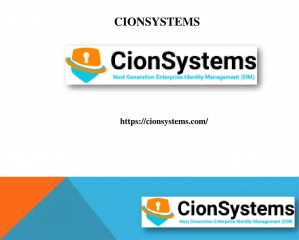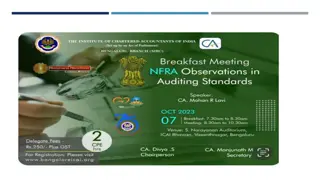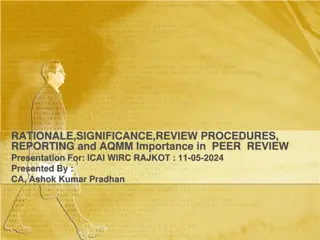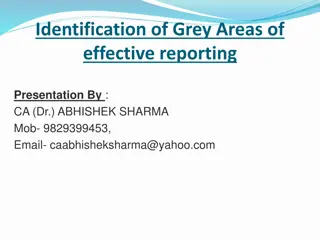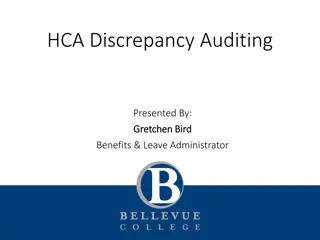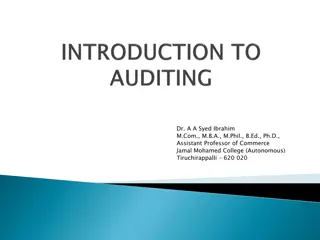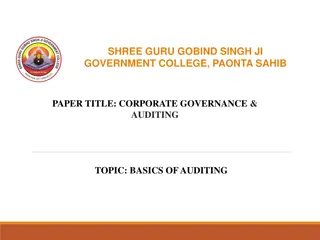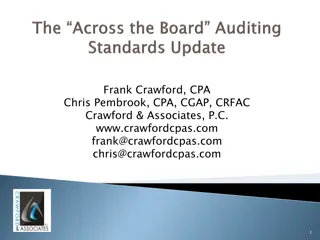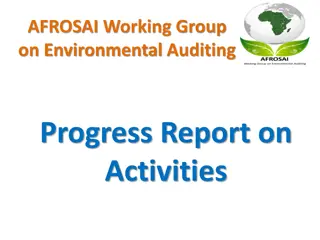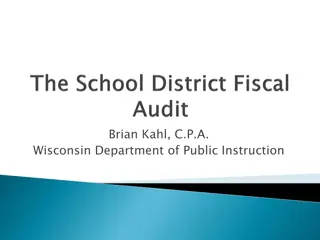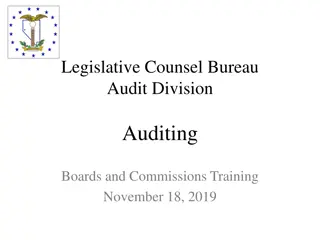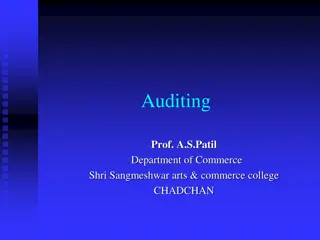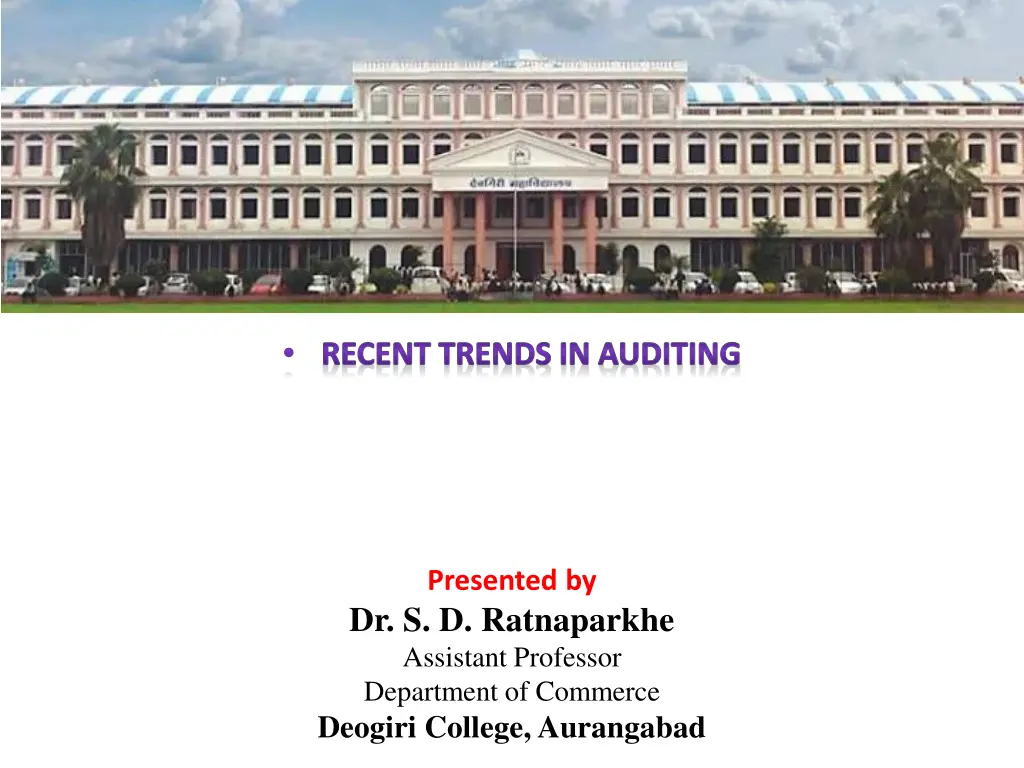
Recent Trends in Auditing - Insights and Advantages
Uncover the recent trends in auditing with a focus on cost audit, its objectives, and advantages. Understand how cost audit helps in detecting errors, controlling costs, and facilitating efficient industry functioning. Explore the importance and benefits of cost audit for both management and government decision-making.
Download Presentation

Please find below an Image/Link to download the presentation.
The content on the website is provided AS IS for your information and personal use only. It may not be sold, licensed, or shared on other websites without obtaining consent from the author. If you encounter any issues during the download, it is possible that the publisher has removed the file from their server.
You are allowed to download the files provided on this website for personal or commercial use, subject to the condition that they are used lawfully. All files are the property of their respective owners.
The content on the website is provided AS IS for your information and personal use only. It may not be sold, licensed, or shared on other websites without obtaining consent from the author.
E N D
Presentation Transcript
RECENT TRENDS IN AUDITING Presented by Dr. S. D. Ratnaparkhe Assistant Professor Department of Commerce Deogiri College, Aurangabad
RECENT TRENDS IN AUDITING
Cost Audit It is an audit process for verifying the cost of manufacture or production of any article, on the basis of accounts as regards utilization of material or labour or other items of costs, maintained by the company. In simple words the term cost audit means a systematic and accurate verification of the cost accounts and records and checking of adherence to the objectives of the cost accounting. As per ICWA London cost audit is the verification of the correctness of cost accounts and of the adherence to the cost accounting plan. The ICWAI defines cost audit as system of audit introduced by the government of India for the review, examination and appraisal of the cost accounting records and attendant information required to be maintained by specified industries From above definition of cost audit, it is clear that cost audit is a systematic examination of cost accounts to verify correctness of cost accounting records. As per the Companies (Cost records and Audit) Rules,2014 provides the classes of companies, engaged in the production of goods or providing services having an overall turnover from all the its products and services of 35 cr. Or more during the immediately preceding FY, required to include cost records in their books of accounts. These companies include Foreign Companies defined in Section 2 (42) of the Act, but exclude a company classified as a Micro enterprise or a Small and Medium enterprise development Act,2006
Objectives of Cost Audit To establish the accuracy of costing data. This is done by verifying the arithmetical accuracy of cost accounting entries in the books of accounts. To ensure that cost accounting principles are governed by the management objectives and these are strictly adhered in preparing cost accounts. To ensure that cost accounts are correct and also to detect errors, frauds and wrong practice in the existing system. To check up the general working of the costing department of the organization and to make suggestions for improvement. To help the management in taking correct decisions on certain important matters i.e. to determine the actual cost of production when the goods are ready. To reduce the amount of detailed checking by the external auditor if effective internal cost audit system is in operation.
Advantages of Cost Audit: To The Management Cost audit helps in detection of errors and frauds. The management gets accurate and reliable data based on which they can make day-to-day decisions like price fixation. It helps in cost control and cost reduction. It facilitates the system of standard costing and budgetary control. It helps the management in inter-unit / firm comparison. It enables the management to identify loss making propositions. To The Government Cost audit ensures efficient functioning of the industry. This in turn, nurtures a healthy competition among the different companies and paves a path for fast progress. It helps in identification of sick units and enables the Government to make relevant decisions. It helps in fixing prices in the case of essential commodities and checking undue profiteering. It enables to take decisions as to granting of subsidies, incentives and protection to various industries. It helps to take decisions as to levies, duties and taxes.
Advantages of Cost Audit To the Society Cost audit enables the Government to fix prices of essential commodities. This safeguards the interests of the society. Cost audit enables the Government to keep a check on undue profiteering by the manufacturers and avoids artificial price rise due to monopolistic tendencies. To the Shareholders Cost audit reveals whether any of the products of the company are making losses. Thus though the company making an overall profit, a loss making line may eat up the company s profits. This is brought to the notice of the shareholders and the management is forced to take remedial measures, thereby making optimum utilisation of resources. Cost audit ensures that the shareholders get a fair return on their investments.
TAX AUDIT
Section 44AB of the Income Tax Act, 1961 Section 44AB of the Income-tax Act, Section 1961 contains the provisions for the tax audit of an entity. As per these provisions, tax audit shall be conducted by a Chartered Accountant who ensures that the taxpayers has maintained proper books of account and complied with the provisions of the Income-tax Act. Tax Audit conducted by a Chartered Accountant is reported to the Income-tax department in Form no. 3CA/3CB and Form no. 3CD along with the income tax return.
Who can conduct tax audit under section 44AB Tax audit can be conducted by a Chartered Accountant who holds the certificate of practice and is in full-time practice. However certain classes have been defined who cannot conduct tax audit under section 44AB. The tax auditor (CA) carries out a systematical examination of books of account as per the formats prescribed by the department.
MANAGEMENT AUDIT
Management Audit A management audit is an independent and systematic analysis and evaluation of a company s overall activities and performances. It is a valuable tool used to determine accomplishments and achievements of the company.] the efficiency, functions, The primary objective of the management audit is to identify errors in management activities and suggest possible changes. It guides the management to manage the operations most effectively and productively. In other words, a management audit is involved in evaluation and assessment of the management system and information in the various departments or the entire company. Its reach has been extended to review system and subsystem, authorization, procedure, accountability, quality of data generated, quality of personnel, etc.,
Scope of Management Audit: A management audit is vast as compared to financial review because it not only evaluates finance but also other features of a company. It has an efficiency for assessing management from top to lower level. Few main scopes of management audit are described below: Calculate the Effectiveness of the Management- It audits the entire level of management of a company. Execution of Principals and Policies- It reviews whether the policies and the principals deployed by the company is effective and successful. Locate and Examine the Differences-It helps to identify the differences in productivity and if the pattern set by the company is not fulfilled. Suggest for Improvement- The management audit suggests improvement in areas, e.g. purchase, sale, finance, administration, human resources, etc.,
Objectives Of Management Audit Verify Efficiency- It aims at increasing productivity at all the levels of management and execution of policies. Give Reccomdation to Increase Efficiency- the management audit marks the incapabilities in various levels of management and provides suggestions to enhance the efficiencies. Evaluates the Potential of Policies and Planning- It audits and evaluates the policies and plannings structured by the management and judge if its appropriately implemented. Increase Profit- It helps to increase the profit margin by providing solutions to maximize the company s resources in a valuable way.
FORENSIC AUDIT
Forensic audit Definition: Forensic audit is the kind of financial information investigation services that provide by professional forensic accounting firm which normally required by entity as the result of legal purposes. Forensic audit normally required to have the number of skill and background that add up to the auditing and accounting skill. In general, forensic audit need both accounting skill and auditing skill. This is because the works they performs are related to investigation on financial reporting. In order to perform an investigation on financial Statement as well as financial information, forensic auditor need to deeply understanding how accounting record are performed as well as accounting treatments from the normal accounting treatment to the complex accounting treatment. Because fraud over financial reporting normally involved with the critical process as well as critical treatment.
COMPUTER BASED AUDIT AUDIT
Auditing in a computer-based environment Application controls Input controls Processing controls Output controls Master file controls
Computer Assisted Audit Techniques (CAATs) The practicality of carrying out manual testing The cost effectiveness of using CAATs The availability of audit time The availability of the audit client s computer facility The level of audit experience and expertise in using a specified CAAT The level of CAATs carried out by the audit client s internal audit function and the extent to which the extern al auditor can rely on this work
STANDARD AUDITING PRACTICES
Standard Auditing Practices The Preface to the Statements on Standard Auditing Practices is an important document which gives an insight into the Auditing Practices Committee (now known as the Auditing and Assurance Standards Board) as well as the Statements on Standard Auditing Practices (now known as the Auditing and Assurance Standards). It deals with aspects like, scope and functions of the Auditing Practices Committee, scope of the Statements on Standard Auditing Practices, procedure for issuing Statements on Standard Auditing Practices, Compliance with the Statements on Standard Auditing Practices, Statements, and effective date for Statements on Standard Auditing Practices. position of existing


